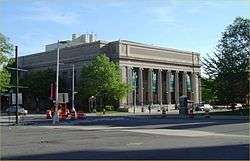United Artists Theatre Building
The United Artists Theatre Building is a vacant high-rise tower in downtown Detroit, Michigan, standing at 150 Bagley Avenue. It was built in 1928 and stands 18 stories tall. The building was designed by architect C. Howard Crane in the renaissance revival architectural style, and is made mainly of brick. Until December 29, 1971, it was a first-run movie house and office space, and then after that, the theatre saw sporadic usage until 1973. The United Artists Theatre, designed in a Spanish-Gothic design, sat 2,070 people, and after closing served from 1978 to 1983 as the Detroit Symphony Orchestra's recording theater. After the theater closed, the office block struggled as tenants moved to suburbs. It finally closed in 1984. An original 10-story, vertical UA sign was replaced in the 1950s with a marquee that remained until 2005. The building once shared a lot with the now demolished Hotel Tuller.
| United Artists Theatre Building | |
|---|---|
 | |

| |
| General information | |
| Type | Commercial offices proposed residential |
| Location | 150 Bagley Street Detroit, Michigan |
| Coordinates | 42.335549°N 83.052328°W |
| Completed | 1928 |
| Height | |
| Roof | 230 ft (70 m) |
| Technical details | |
| Floor count | 18 |
| Floor area | 217,300 sq ft (20,190 m2) |
| Design and construction | |
| Architect | Charles Howard Crane Elmer George Kiehler |
| References | |
| [1][2] | |
In preparation for the 2006 NFL Super Bowl, graffiti was removed from all the windows of the building, and the lower levels received a coat of black paint to hide the graffiti work at the base of the building. The old theater marquee was also removed.
In 2006, Ilitch Holdings announced it would market the building.[3] Despite a promotional website created in 2017 and assurances of an intent to redevelop the historically significant structure, Ilitch Holdings has yet to begin any redevelopment. The company has a history of buying historic properties, voicing an intent to redevelop them, and later turning them into parking lots following increased decay.[4][5][6]
References
- United Artists Theatre Building at Emporis
- "United Artists Theatre Building". SkyscraperPage.
- Lisa M. Collins (13 January 2006). "Ilitches Lift City Hopes". The Detroit News. Retrieved 30 September 2010.
- "For preservationists, Ilitch leaves a complex legacy". Crain's Detroit Business. 2017-02-18. Retrieved 2018-04-18.
- "The leveling of Cass Corridor and Foxtown". Curbed Detroit. Retrieved 2018-04-18.
- Ikonomova, Violet. "Preservationists call on Ilitch family to halt 'illegal' demolition plans in Cass Corridor". Detroit Metro Times. Retrieved 2018-04-18.
Further reading
- Hauser, Michael & Marianne Weldon (2006). Downtown Detroit's Movie Palaces (Images of America). Arcadia Publishing. ISBN 0-7385-4102-8.
- Hill, Eric J. & John Gallagher (2002). AIA Detroit: The American Institute of Architects Guide to Detroit Architecture. Wayne State University Press. ISBN 0-8143-3120-3.
- Meyer, Katherine Mattingly and Martin C.P. McElroy with Introduction by W. Hawkins Ferry, Hon A.I.A. (1980). Detroit Architecture A.I.A. Guide Revised Edition. Wayne State University Press. ISBN 0-8143-1651-4.CS1 maint: multiple names: authors list (link)
- Sharoff, Robert (2005). American City: Detroit Architecture. Wayne State University Press. ISBN 0-8143-3270-6.
External links
- United Artists Theatre at Buildings of Detroit
- recent image of the interior of the theatre.
